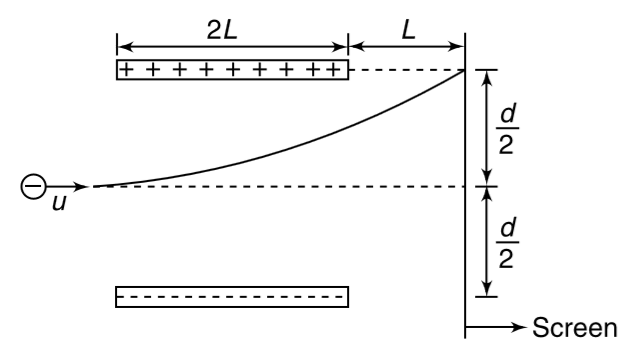A uniform electric field exists in the region between toe oppositely charged plane parallel plates. An electron is released from rest at the surface of the negatively charged plate and strikes the surface of the opposition plate 2 cm away from the first in an intercval of 1.5×10−8s . Find (a) the electric intensity ,(b) the velocity of the electron when it strikes the second plate.
The correct Answer is:(a) 1000Vm−1 (b) 2.67×106ms−1
Step by step video, text & image solution for A uniform electric field exists in the region between toe oppositely charged plane parallel plates. An electron is released from rest at the surface of the negatively charged plate and strikes the surface of the opposition plate 2 cm away from the first in an intercval of 1.5 xx 10^(-8)s . Find (a) the electric intensity ,(b) the velocity of the electron when it strikes the second plate. by Physics experts to help you in doubts & scoring excellent marks in Class 12 exams.
Topper's Solved these Questions
- BOOK - NN GHOSHCHAPTER - ELECTRIC FIELD AND POTENIALEXERCISE - EXERCISE21videos
ELECTRIC FIELD AND POTENIAL
- BOOK - NN GHOSHCHAPTER - DYNAMO, MOTOR, TRANSFORMEREXERCISE - EXERCISE8videos
DYNAMO, MOTOR, TRANSFORMER
- BOOK - NN GHOSHCHAPTER - ELECTROMAGNETIC INDUCTIONEXERCISE - EXERICISES-B18videos
ELECTROMAGNETIC INDUCTION
Similar Questions
A uniform electric field exists in a region between two oppositely charged plates. An electron is released from rest at the surface of the negatively charged plate and strikes the surface of the opposite plate, 3.0 cm away, in a time 1.5×10−8s. Just as the electron strikes the second plate, what are the its (a) momentum magnitude and (b) kinetic energy ? (c ) What is the magnitude of the electric field →E ?
View SolutionAn electron (charge = e, mass = m) is projected horizontally into a uniform electric field produced between two oppositely charged parallel plates, as shown in figure. The charge density on both plates is ± σC/m2 and separation between them is d. You have to assume that only electric force acts on the electron and there is no field outside the plates. Initial velocity of the electron is u, parallel to the plates along the line bisecting the gap between the plates. Length of plates is 2L and there is a screen perpendicular to them at a distance L. (i) Find s if the electron hits the screen at a point that is at same height as the upper plate.
(ii) Final the angle q that the velocity of the electron makes with the screen while it strikes it.
 View Solution
View Solution
Knowledge Check
- Question 1 - Select One
When 1020 electrons are removed from the surface of a neutral metal plate, the electric charge on it (in coulomb) is
A+16B−1.6C10−19D1019 - Question 2 - Select One
A parallel plate capacitor has an electric field of 105V/m between the plates. If the charge on the capacitor plate is 1μC, the force on each capacitor plate is
A0.5 NB0.05 NC0.005 ND5 N - Question 3 - Select One
A parallel plate capacitor has an electric field of 105V/m between the plates. If the charge on the capacitor plate is 1μC, then force on each capacitor plate is-
A0.1NB0.05NC0.02ND0.01N
The distance between charged parallel plates is d. An electron -proton is released somewhere in the gap between the plates and it is found that the proton reaches the negative plate at the same time as electron reaches the positive plate. At consider only electric force. The mass of electron is me and mass of proton is mp.The electric field between plates is E.
View SolutionAn electron starting from rest takes 14×10−9 sec to reach from one plate to other of a capacitor placed 2 cm apart. If charge to mass ratio of electron is 1.8×1011CIkg. Then find the potential difference between the plates.
View SolutionThere exists a uniform and constant magnetic field of strength B in the space betweent he plates of a charged parallel plate capacitor. The charge density on the plate is σ and length of the plate is l. An electron is projected in the space between the plates along the length of the plate. It is foudn that velcoity of the electron does not change. Find the time taken by the electron to come out of the capacitor. The figure describes the situtation. Ignore the gravity.
 View Solution
View SolutionAn electron (e,m) is projected into a uniform electric field E vertically downward between parallel plates at separation d, with velocity v0. The electron enters the electric field at a point midway between the plates. Find
(a) the magnitude of electric field if electron emerges from the electric field just at the edge of upper plate.
(b) the direction of the velocity of electron as it emerges from the electric field.
(c ) the equation of trajectory followed by electron.
The length of plates is L and consider only electric force.View SolutionThe surface charge densities on two square plates of a parallel plate capacitor are to +σand−σ respectively. What is the magnitude of the electric field in the region between the plates?
View Solution
